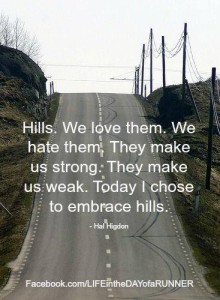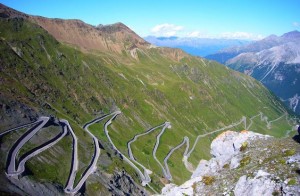
Hill Climbing Technique – Get Fast!
Hill climbs make cycling challenging… and worth it! Some people love them, some people hate them. I choose to love them, or at least that is what I tell myself and so should you!
Effort
The most important aspect of hill climbing is maintaining a steady effort from the bottom all the way to the top. This is a difficult thing to achieve. If you have a heart rate monitor there is a lag of approximately thirty seconds to one minute – keep this in mind. If you are going off of perceived effort – the beginning of the hill is perceptively easy and the top seems incredibly difficult at the same effort. Power meters are the only way of receiving instantaneous feedback of your actual effort.
Not everyone wants a power meter, so the best advice I have is:
- Start out slower than you think at the bottom of the hill
- Be familiar with the course or ride so you know how long the hill is and what type of effort is required
- Practice the hill and see what pace works for you
Cadence
You can mash or you can spin. Everyone is different, but for most people it is more efficient to spin up a hill (maintaining a cadence of 80 to 105). Maintaining this high of a cadence may be difficult in the beginning but as your fitness improves it will become more natural.
What happens if you are in the easiest gear and you are unable to maintain a cadence of at least 80? It is likely that you need to get a compact or triple crankset. My first bike should have had a triple crankset up front. My fitness was nowhere close to being able to spin up hills. I have a hill 3 minutes from my house that has a 7% grade and I used to mash up it at 55 rpm and be cooked by the top. Mashing just burns you out faster.
 Pedaling
Pedaling
Pedal in a circle! The idea of the pedal stroke is to apply force all the way around the pedal stroke by pushing down, pulling back at the bottom (as if you are scraping mud off your shoes), lift up at the back and push through the top of the stroke. Another way of thinking of this is imagining that your cranks were elastic and that you’re trying to stretch them all the way around the full pedal stroke.
Most of us are actually not very good at pedaling in a smooth circle. That includes me! Over this past year it ‘s what I have focused on the most. In the beginning I could pedal in a smooth-ish circle for about 20 solid seconds… yup… 20. I would then have to rest, refocus and go for another 20 seconds. After 10 repetitions of this (just over 3 minutes) my hip-flexors would be screaming.
I went from a hill climb masher and down stroke pusher to spinning in a smooth circle and the difference is amazing. It is has been one of my core focuses over the past year and will continue to be.
Position
While climbing you should:
- Sit upright in order to open your lungs for more oxygen intake to engage larger muscle groups.
- Have a relaxed grip so you do not waste energy with a death grip and cause tension to limit your oxygen intake.
- Have a quiet upper body (don’t bob your head back and forth – it wastes energy and is usually caused by mashing on the pedals instead of spinning)
- Mostly remain seated:
Standing vs. Sitting.
It is more efficient to stay seated during a hill climb than to stand; however, you can produce more power while standing.
When you stand your core does more work because your pelvis is not anchored to the saddle so your core and back muscles have to pull up on an unweighted pedal resulting in a higher energy expenditure. You also engage your arms to pull down on the bars and support yourself.
When is it beneficial to stand?
- On long climbs it is beneficial to stand to engage different muscles groups and let the other ones have a rest. Try to save this for the steep sections of the climb.
- When your cadence slows down and it is difficult to continue “spinning”.
- When cresting over the top of a summit to transition into a flat or descent. It can give your muscles a feeling of relief.
- When you need to go as fast as possible as it engages more muscle groups, but be careful as it expends more energy.
Here is an article on standing vs. sitting and here’s a more sciency one on Standing vs. Sitting.
Gear Shifting
Gear shifting comes with experience. Shift to an easy gear to soon and lose your momentum. Shift to late and you run the risk of not being able to shift at all.
When you shift down to an easier gear there is more strain on the chain and sometimes it will not shift if there is too much pressure. Ease up on the pedals for a brief moment to allow the shift to happen. Shifting gears becomes a “feel” thing. Over time you will instinctively know how much pressure your chain can take and how brief of a moment you have to stop pedaling for.
Additionally, when you change from a seated position to a standing position you should shift up at least one, if not two gears when your foot is at the two o’clock position because when you stand your cadence slows down. You do not want to lose momentum or have the person behind you run into you.
Mental Attitude
Mental attitude towards hills makes a big difference on how you perform when hill climbing. You have to stay in a positive space no matter how much you are hurting and believe you can do it. I use little mind tricks as simple as envisioning rockets on my bike and then I literally say, “rockets engage!” embarrassing, but effective. Never be mentally defeated and always finish a climb no matter how slow you have to go… even if you have to walk.
Subscription
If you liked this post subscribe to my newsletter at the top right of the page to receive more like it!